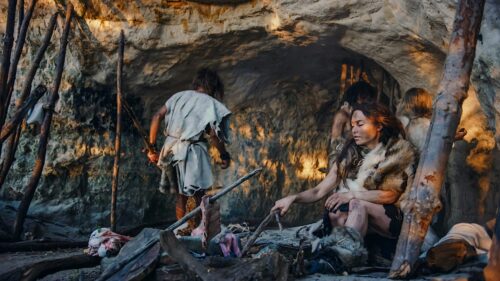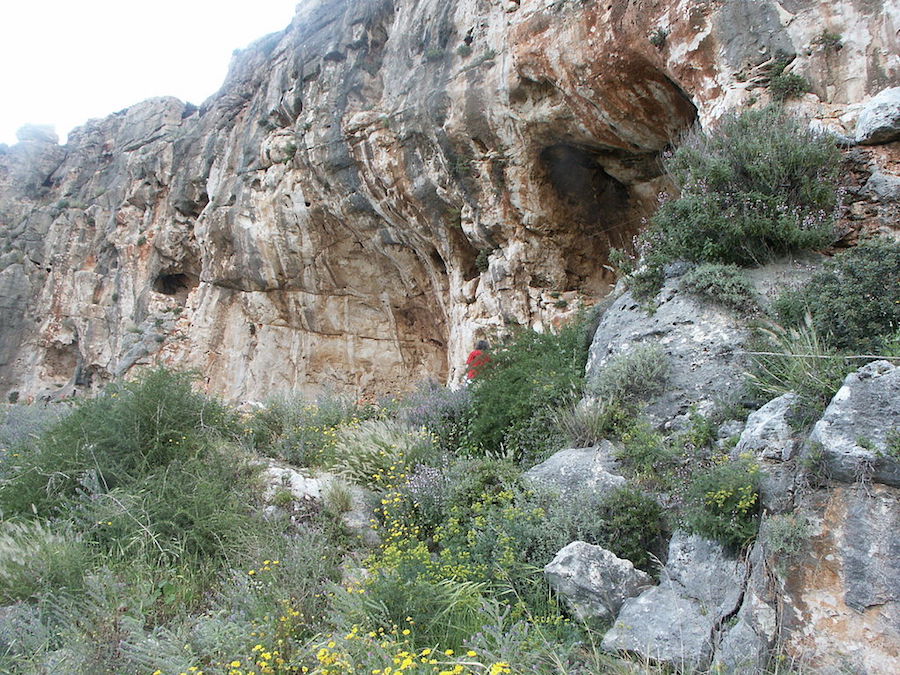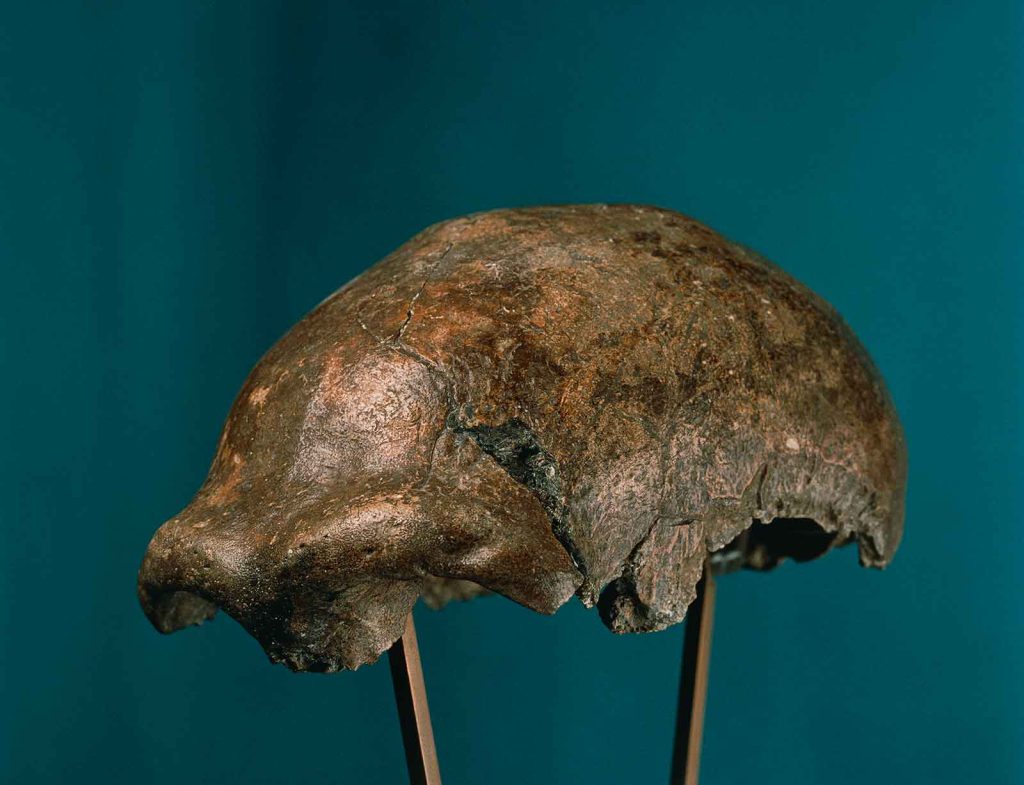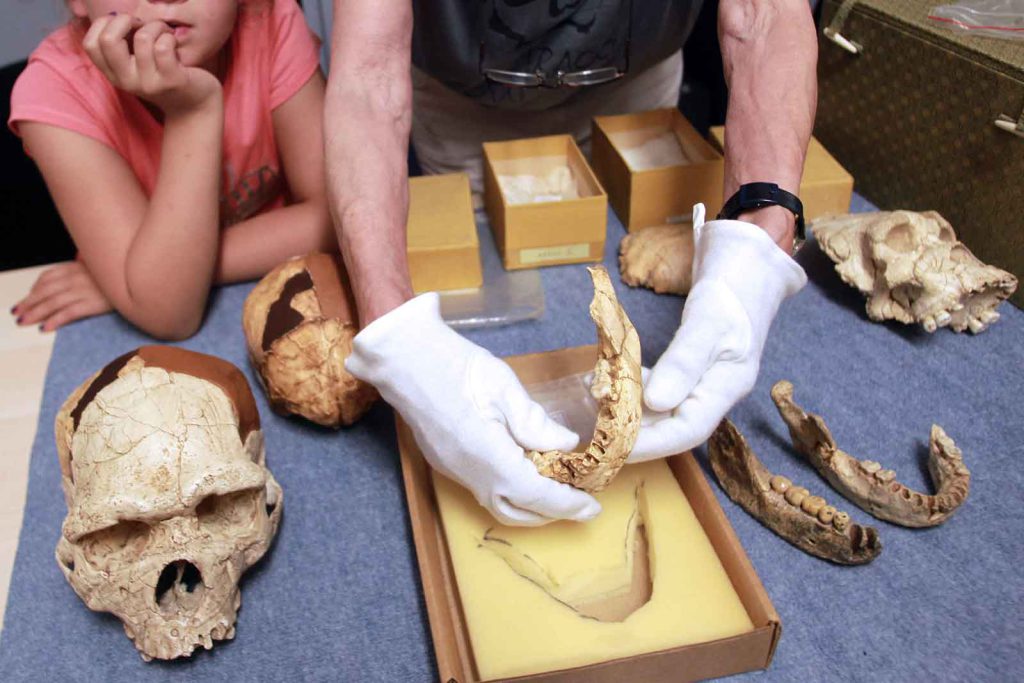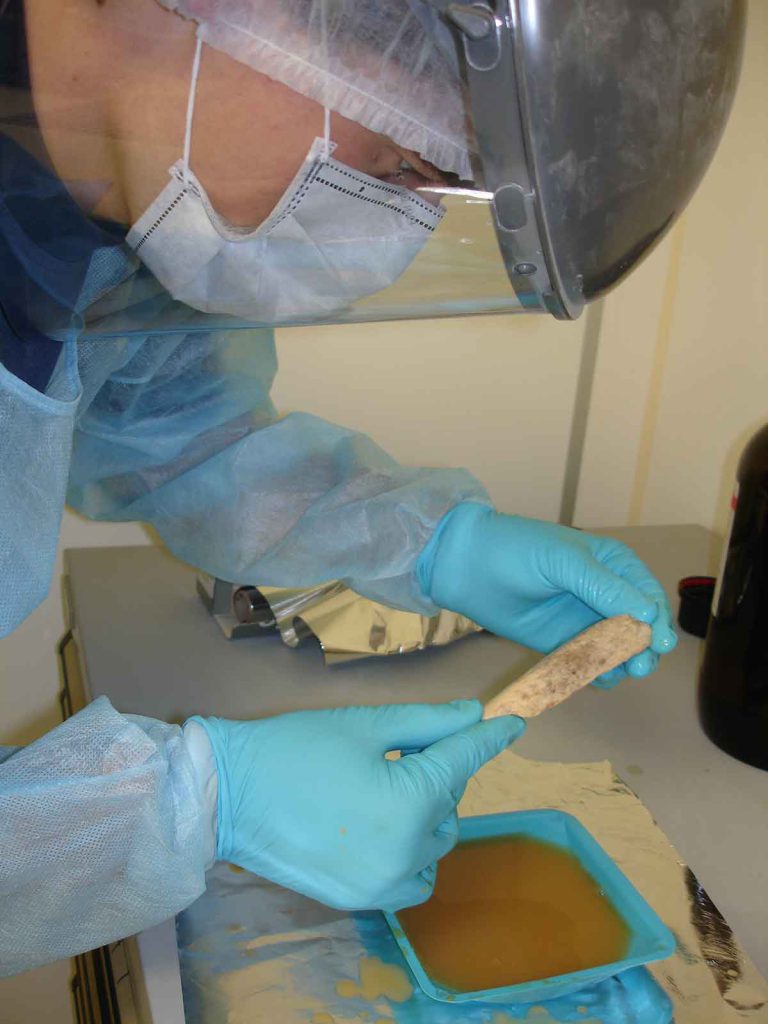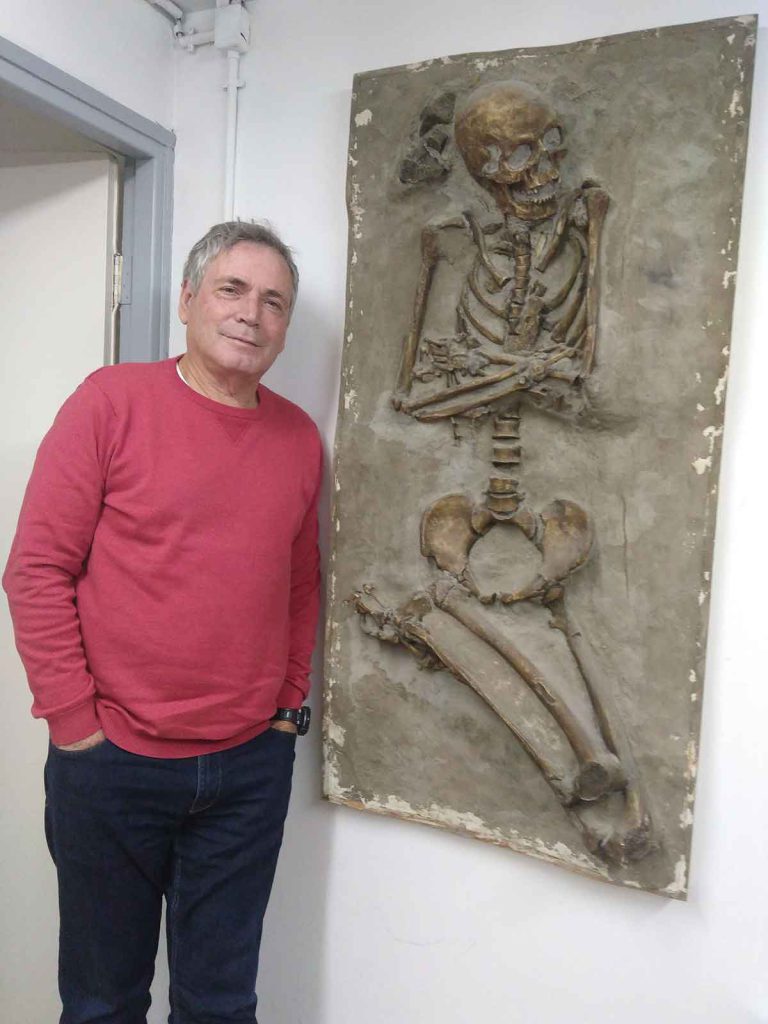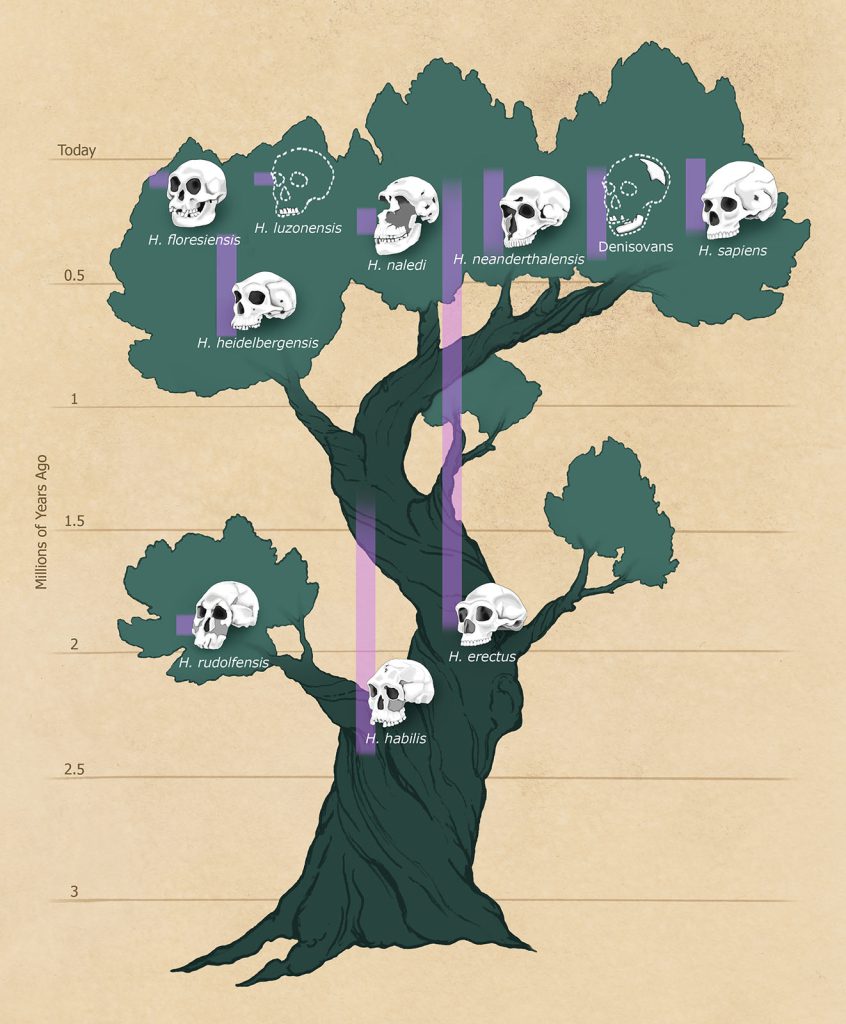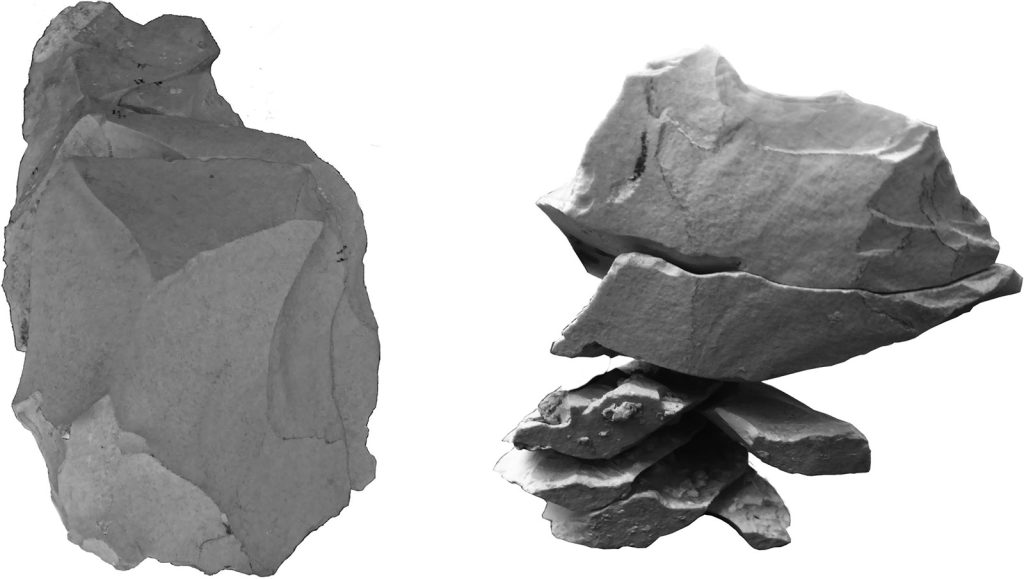Were Neanderthals More Than Cousins to Homo Sapiens?
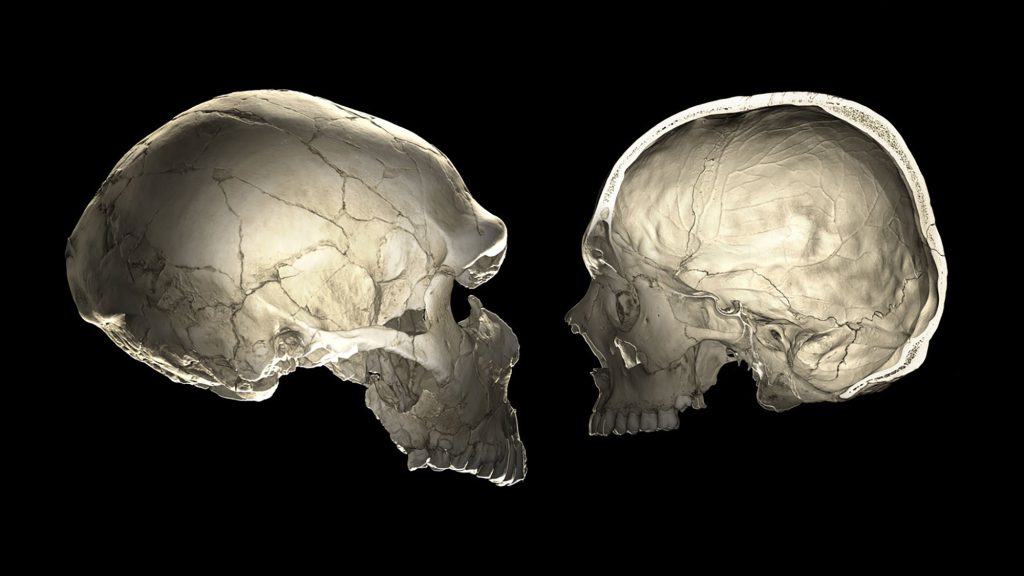
Please note that this article includes images of human remains.
Around 200,000 years ago, in what is now northern Israel, a small band of tech-savvy humans dragged home and dismembered a bounty of wildlife. Using exquisitely pointed flint spearheads and blades, they hunted and butchered myriad prey, including gazelles, deer, and now-extinct aurochs, the ancestors of modern cattle.
In the cool, humid climate of the coastal plain, these early Homo sapiens foraged for acorns in nearby forests of oak, olive, and pistachio. They ate the saline leaves of shrubby saltbush and lugged ostrich eggs back to the cave, where they slurped down the yolks.
This vision of the past comes from Haifa University archaeologist Mina Weinstein-Evron. In 2002, she and her colleagues discovered the upper jaw and teeth of a H. sapiens that dated to between 177,000 and 194,000 years old in Israel’s Misliya Cave, with animal bones and sharp tools nearby.
It’s probable, Weinstein-Evron explains, that these humans migrated to the Arabian Peninsula more than 200,000 years ago, trekking along lush corridors out of Africa. “We don’t know how many crossed, and how many of them perished, and how many went back. We only know that these people arrived,” she says.
We also know that they were likely not alone. Based on small finds of teeth and bones from local caves, “we know that the area was inhabited by Neanderthal-like creatures,” or the predecessors of Neanderthals, at that time, says Tel Aviv University anthropologist Israel Hershkovitz, an expert on modern human origins.
While out foraging, H. sapiens may have mated with these Neanderthal-like inhabitants. In this land that later birthed the Bible, they likely knew each other in the Biblical sense.
The humans who lived in the Misliya Cave were part of a population that, many scholars suspect, ultimately died out. [1] [1] Many anthropologists use the term “human” to not only mean modern Homo sapiens but also many other hominin species on our family tree. (In other words, for some scholars, Neanderthals have always been “human,” as members of the genus Homo.) In our story, we use “human” broadly while using “H. sapiens” to refer to the only living species of the Homo lineage and “modern humans” to point to “all humans living today.” Later waves of H. sapiens that left the African continent succeeded in reproducing and spreading out. But braided into the story of those human migrations is that of Neanderthals, hominins—members of our family tree closest to modern humans—who may have first evolved in Europe from African ancestors some 400,000 years ago.
Many scientists now suspect that H. sapiens and Neanderthals met and mingled their genes multiple times. Geneticists have documented how Neanderthal genes survive today among modern humans, evidence of some earlier instances of interbreeding.
New studies, made possible in part by computational techniques that enable researchers to analyze huge quantities of genetic data, show that H. sapiens and Neanderthals interbred far more than previously imagined. Indeed, their proclivity for pairing off has led many researchers to question the old dictum that Neanderthals and H. sapiens were separate species.
Such ideas raise questions as to what it really means to be a distinct “species.” They also raise the possibility that perhaps H. sapiens did not outcompete Neanderthals into extinction, as some scientists have suggested. Rather, one species may have simply absorbed the other—and so, Neanderthals, in a sense, could survive in us.
In 1856, in the Neander Valley of Prussia (now Germany), limestone cutters discovered the partial skeleton of a thick-boned, brow-ridged hominin in a cave. A German anthropologist named Hermann Schaaffhausen examined the bones.
Schaaffhausen realized that the skull differed from that of modern humans but concluded it could nonetheless belong to what he called a “barbarous and savage race” of human. However, his contemporary, Irish geologist William King, disagreed.
King noted that the skull of this fossil, with its “strong simial [apelike] tendencies” was “generically distinct from Man.” In 1863, King declared it a new species, which he named Homo neanderthalensis.
Scientists have been arguing over whether H. sapiens and H. neanderthalensis are truly separate species ever since. By appearances alone, Neanderthal fossils resemble ours—they are clearly members of our hominin family tree. But on closer examination, Neanderthal features are also quite distinct.
“There was debate back and forth: Was this just a weird variant of us—a more primitive, brutish-looking thing than living humans—or was it really something different?” asks physical anthropologist and evolutionary biologist Jeffrey Schwartz of the University of Pittsburgh.
Schwartz can rattle off a raft of anatomical differences between H. sapiens and Neanderthals: H. sapiens are flat-faced; the Neanderthal face sticks out. Neanderthals had boxy, stout bodies, and their major arm and leg bones were thick. H. sapiens, by contrast, have thinner, gracile bodies. Neanderthals had different teeth and thumb lengths, as well as longer collarbones.
The argument might have been confined to questions of anatomy had it not been for a singular discovery in 2010. A team led by evolutionary geneticist Svante Pääbo of the Max Planck Institute for Evolutionary Anthropology in Leipzig, Germany, extracted bits of DNA from Neanderthal fossils and published an early version of the Neanderthal genome.
By comparing portions of the Neanderthal genome with the genomes of five modern-day humans—from Southern Africa, West Africa, Papua New Guinea, China, and France—they found that Neanderthals share more genetic snippets with humans in Europe and Asia today than with people living presently in much of sub-Saharan Africa.
Pääbo and his team’s findings showed that between 1 and 4 percent of the genomes of modern non-African humans consist of Neanderthal DNA. That overlap suggested, for the first time, that our H. sapiens ancestors could have had intimate encounters with Neanderthals.
That study would be the first of many to indicate that these two hominins interbred. And such studies matter to the question of whether Neanderthals and H. sapiens are one or two species because, by biologist Ernst Mayr’s “classic definition,” Hershkovitz explains, “if two organisms can breed and produce fertile offspring, it means that they belong to the same species.”
Genetic research has long faced a challenge in scale. There are an estimated 21,000 genes in the human genome that code for proteins, complex molecules that do most of the work in cells and play crucial roles in the body. Sequencing these genes involved studying the 3 billion DNA base pairs that make up the human genome.
Every advance that makes studying an individual genome cheaper, more accurate, and faster is a major step forward in understanding how individuals—whether H. sapiens, Neanderthal, or other—compare. For all of those reasons, the development of artificial intelligence (AI) techniques, which enable researchers to set computers to solving problems and conducting analyses, has been a game changer.
AI has not only helped to confirm earlier genetic findings that H. sapiens and Neanderthals interbred, but also suggested their sexual encounters occurred to a degree that scholars never anticipated. All of this builds the case that the two could be the same species.
In 2018, for example, research published by population geneticists Fernando Villanea and Joshua Schraiber, then at Temple University in Philadelphia, made use of an AI tool called a deep learning algorithm, which seeks patterns in complex layers of data and is inspired by the brain’s approach to acquiring knowledge.
Computer scientists “train” algorithms by instructing them to identify specific patterns based on previously assembled data. In this case, Villanea and Schraiber used an algorithm to spot Neanderthal ancestry.
The pair then analyzed the distribution of Neanderthal DNA in the genomes of about 400 contemporary East Asians and Europeans, people whose ancestors have lived in these regions for a long time. This data came from the 1000 Genomes Project, an international collaboration to catalogue human genetic variation.
By the “classic definition,” explains anthropologist Hershkovitz, “if two organisms can breed and produce fertile offspring, it means that they belong to the same species.”
Schraiber and Villanea found fragments of Neanderthal ancestry: about 1.5 percent in each individual and 1.7 percent among people in East Asia specifically. Fabrizio Mafessoni, an evolutionary geneticist at the Max Planck Institute for Evolutionary Anthropology, reviewed Schraiber and Villanea’s findings and argued that the proportion of Neanderthal fragments among modern humans was a bit higher than would be expected if there had only been one episode in which these two populations mated.
“The intuitive explanation,” Schraiber says, “is that there were multiple episodes of interbreeding and that [populations in East Asia] interbred more.”
A 2019 study, co-led by Oscar Lao, who studies population genomics at Spain’s National Center of Genomic Regulation, and Jaume Bertranpetit, an evolutionary biologist at Pompeu Fabra University in Barcelona, used deep learning algorithms to identify a hitherto-unknown human population, a hybrid of Neanderthals and Denisovans. (The Denisovans are archaic hominins identified from the Denisova Cave in the Altai Mountains of Siberia.)
Their data showed that—given the distribution of Neanderthal DNA in various living human groups—Neanderthals interbred with Denisovans in East Asia, creating the Neanderthal-Denisovan population, and their hybrid descendants did the deed with modern humans before their arrival in Australia some 60,000 years ago.
That evidence for “admixing” between Neanderthals, Denisovans, and modern humans, Bertranpetit says, indicates “that all of these populations belong to a single lineage.”
Still other research, published in 2017, indicates that gene flow from early H. sapiens into Neanderthals might have occurred earlier in humanity’s story—around the time that the Misliya Cave H. sapiens were sucking the yolks of those ostrich eggs.
That study, led by Cosimo Posth, an archaeogeneticist at the Max Planck Institute for the Science of Human History in Jena, Germany, examined DNA collected from an approximately 120,000-year-old femur bone excavated in a cave in southwestern Germany.
Specifically, they turned to mitochondrial DNA, genetic information handed down from mother to child and found within the cells’ energy-generating structures called mitochondria. The analysis concluded that the ancestors of Neanderthals and H. sapiens interbred at some point between 270,000 and 220,000 years ago, most likely in the Levant.
Taken together, these studies strengthen the case that H. sapiens-Neanderthal pairings occurred and that such mating was by no means unusual. Rather, H. sapiens, Neanderthals, Denisovans, and their hybrids all interbred (hinting, yes, that all three were the same species). And that mixing may have occurred as early as some of the first forays of modern human ancestors out of Africa.
“For hundreds of thousands of years, modern humans as well as archaic humans, such as Neanderthals and Denisovans, have been … crossing modern-day borders that, of course, were not existing in the past and multiple times admixing and exchanging genetic material,” Posth says. “This was not the exception but was the norm.”
If “species” is defined in large part by the ability to breed and have young who can also reproduce, one might argue that Neanderthals and H. sapiens are indeed one species. And many of the scientists who work on these studies agree. Yet some experts still contend otherwise.
Approximately 75 kilometers south of the Misliya Cave, Hershkovitz is sitting in his tiny office in Tel Aviv. Around him, the skulls of H. sapiens—the oldest dating back 15,000 years—jostle with one another on shelves lining the walls.
These skulls, which belonged to living, breathing human beings, evoke an aura of a long-forgotten world. And once, earlier still, such humans coexisted with other hominin species. Yet determining how different these species were from each other is difficult. Hershkovitz, for example, sees H. sapiens and Neanderthals as “sister populations” within the same species.
But Mayr’s “classic definition” of a species, based on interbreeding, is riddled with exceptions. For instance, if members of two different species happen to reproduce, they can have offspring but that new generation of “hybrids” may not be able to reproduce.
A horse and a donkey’s offspring, the mule, is typically sterile, for example. But lions and tigers, separate species that in the wild live on different continents, can sire “ligers” or “tigons” in captivity, and those hybrid felines can rarely or occasionally reproduce. In other words, scientists recognize instances where two species remain separate despite interbreeding—and some researchers extend that exception to H. sapiens and Neanderthals.
New York University biological anthropologist Shara Bailey believes H. sapiens and Neanderthals reproduced but remained distinct species—just like lions and tigers. She describes the two hominins as morphologically separate species who diverged from each other at least 800,000 years ago.
“For all intents and purposes, they were separate species,” Bailey says, “but they maintained the ability to hybridize.” Their offspring, she argues, would have been rare and, though able to reproduce, less successful in reproducing compared with their parents. The genetic record, then, indicates that some hybrids did sometimes succeed, contributing Neanderthal DNA to the modern human gene pool.
Bailey’s not alone in this viewpoint. Anthropologist Chris Stringer, at the Natural History Museum in London, also concludes that these populations both were separated long enough in terms of their evolution and were physically distinct enough in their features to remain separate species that occasionally hybridized.
Given the complications in Mayr’s definition, some scholars argue it ought to be replaced. To that end, there are now 20 different conceptions of what a “species” could be—and no strong consensus on which should take center stage. Some scientists subscribe to the theory of species mate recognition, in which members of the same species “recognize” one another as mates through courtship rituals, breeding seasons, or protein compatibility.
And at least one researcher still questions the genetic evidence for interbreeding. Schwartz says he has seen and studied almost every specimen of the entire human fossil record and notes that “Neanderthals are clearly a different species from us: They are so morphologically unique.”
Schwartz doubts the interpretation of genetic evidence thus far. Although dozens of hominins once existed, Schwartz points out, scientists have only sequenced the genomes of three specimens whose species they could clearly identify by their morphology: modern H. sapiens, the Neander Valley Neanderthal, and a 400,000-year-old hominin called Homo heidelbergensis. (Researchers have endeavored to identify the species of other, fragmentary specimens, primarily using genetic clues derived from the definitively identified Neanderthal and H. sapiens fossils.)
Because we don’t know how many hominin species there were—and because the vast majority have not had their DNA sequenced—we can’t know how many of these hominins had genes that were specifically “Denisovan” or “Neanderthal,” Schwartz argues. Therefore, he says, there is no way of knowing whether the DNA sequences extracted from Neanderthals were exclusive to Neanderthals.
“Pääbo and his group are very good technicians,” Schwartz says. “I don’t doubt that they have really worked hard to make sure these sequences are not contaminated.” Still, he says, we lack the DNA of many other hominins. The evidence that the sequenced DNA is specific to Neanderthals is therefore unreliable, he argues, and so claims that they interbred with H. sapiens are also dubious.
“I’m not saying that the comparisons are incorrect or that the sequences are incorrect,” Schwartz says. “I’m saying that the conclusion is not that solid.”
Schwartz doubts that Neanderthals and H. sapiens would have recognized each other as mates: “Neanderthals don’t look like us; we don’t look like them; they wouldn’t move the same way we did,” he says. Also, “they probably smelled different than we do.”
For the moment, then, the answer to whether or not H. sapiens and H. neanderthalensis were the same species is still up for debate (along with the entire messy concept of “species”). But the larger message that comes through with each wave of findings is simple: Despite a long history of derogatory “cave man” descriptors, H. neanderthalensis was probably a lot like us.
The first time H. sapiens and Neanderthals met was likely in the region that is now Israel. Just as the Misliya Cave helps establish how long anatomically modern humans were present in the region, tools associated with Neanderthals, such as spearheads and knives, have been found in other caves in Israel.
But many mysteries remain. Did H. sapiens and Neanderthals whisper sweet nothings to each other beneath the leaves of a pistachio tree? Was there some secret lure, facial or pheromonal, that attracted one to the other? We can only speculate.
Neanderthals were intelligent; they were skilled toolmakers. We don’t know whether they had spoken language, because even though they had vocal anatomy similar to H. sapiens, the soft tissue associated with the vocal box—the area of the throat containing the vocal cords—has not been preserved.
Both H. sapiens and Neanderthals shared a propensity for primping. Neanderthals made jewelry out of animal teeth, shells, and ivory. They decorated themselves with feathers and probably ochre as well.
Some scholars suspect that fierce competition between H. sapiens and Neanderthals pushed the latter from the warmer Levant into an ice-covered Europe. “The world was almost empty,” Hershkovitz says. “The way I personally see this—probably most people would not agree with me—the European Neanderthals had no other choice.”
Though Hershkovitz declines to conjecture as to whether female Neanderthals were forced into sex—rape has been used as a weapon of war through the ages to punish and terrorize—he does offer, “I don’t think it was a happy marriage.”
Others, including Schraiber, posit more peaceful encounters. “I imagine that when humans ran into some vaguely human-like thing, they were like, ‘This is cool,’” he speculates. But, he demurs, “I really don’t know, especially since I’m not an anthropologist, I’m a geneticist.”
Did they whisper sweet nothings beneath the leaves of a pistachio tree? We can only speculate.
At least one researcher, computational biologist Rasmus Nielsen of the University of California, Berkeley, goes further. He hypothesizes that Neanderthals never went extinct: They, or their genes, were simply absorbed into modern humans. In other words, instead of dying out through violence or starvation, the Neanderthal population hybridized with H. sapiens.
Using mathematical models, Nielsen and his colleague Kelley Harris have argued that at one point, the proportion of Neanderthal DNA in humans alive today was as high as 10 percent—and that proportion later dwindled. That 10 percent figure is significant because other researchers have estimated H. sapiens outnumbered Neanderthals 10-to-1, so perhaps, Nielsen contends, the two species interbred to such an extent that they merged together.
Over time, however, modern humans lost significant amounts of Neanderthal DNA, perhaps because it carried harmful mutations. Indeed, another research team, which included Pääbo, found that most Neanderthal genes survive in H. sapiens in regions of non-coding DNA. “The regions that are most important for function—the protein-coding genes—are depleted of Neanderthal DNA,” Nielsen says.
In a Q&A for the journal BMC Biology, Nielsen and Harris write: “It is possible that Neanderthals did not truly die off at all but simply melted together with the human species. One could perhaps argue that Neanderthals did not disappear due to warfare or competition—but due to love.”
If they are right, then whether we were once one species or two does not matter because we are all one now.





























